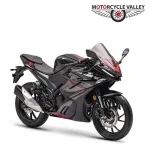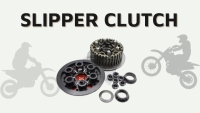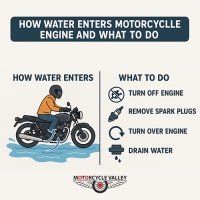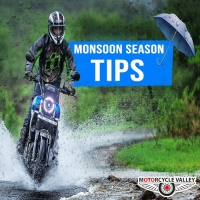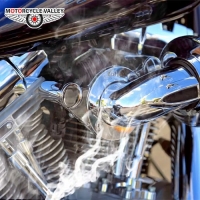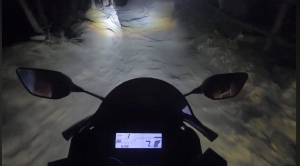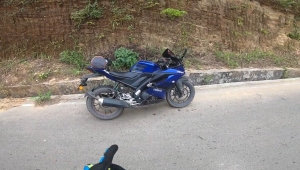How Water Enters a Motorcycle Engine and What to Do
How Water Enters a Motorcycle Engine and What to Do
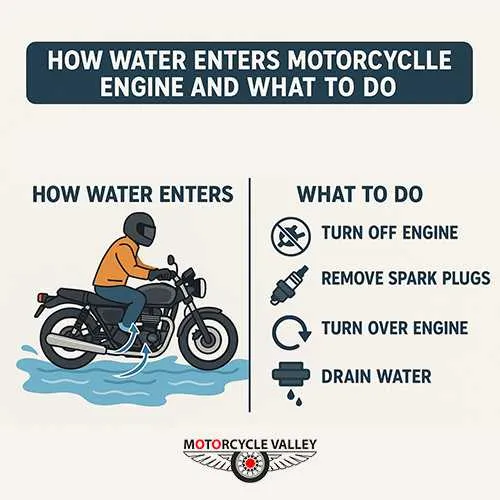
Due to ongoing heavy rainfall, floods, and water logging in various parts of the country, there is a significant risk of water entering motorcycle engines. If water enters the engine, especially into the cylinder, it can cause a serious issue known as hydro lock, which may lead to severe engine damage.
the causes and preventive actions you should take written below:
Components through Which Water Can Enter the Engine
1. Air Intake / Air Filter Box:
• If the motorcycle is submerged in water while the engine is running, water can enter through the air intake and reach the cylinder directly.
• Riding in heavy rain or through standing water can also cause the air filter to become soaked, allowing water to be drawn into the engine.
2. Exhaust Pipe:
• If the bike is fully or partially submerged, water can travel up the exhaust pipe and into the engine.
3. Spark Plug Hole / Damaged Gasket:
• A loosely fitted spark plug or a damaged gasket can provide an entry point for water into the engine.
4. Carburetor or Throttle Body:
• Water may enter the carburetor or electronic fuel injection (EFI) system and mix with the air-fuel mixture, leading to engine problems.
5. Engine Breather Pipe:
• The breather pipe, which balances internal engine pressure, can allow water inside if the bike is submerged.
6. Oil Filler Cap:
• If not sealed properly, water may enter through the oil filler cap and mix with the engine oil.
When Water Entry Is Most Likely:
• When riding through deep water that rises above the air intake level.
• If the motorcycle falls into water, submerging the exhaust or air intake.
• Leaving the bike running in heavy rain or during water logging.
• Storing the motorcycle in a low-lying area where water accumulates.

What You Should Do If Water Gets In:
1. Do Not Attempt to Start the Engine:
• If you suspect water has entered the engine, never try to start it. Doing so may cause severe internal damage.
2. Disconnect the Battery:
• Prevents accidental starting of the engine.
3. Remove the Spark Plug:
• This releases pressure in the cylinder and allows any water to escape.
4. Manually Rotate the Engine:
• Use the kick-start or a hand crank gently to help push water out of the engine.
5. Check the Engine Oil:
• If the oil appears milky or creamy, water has mixed with it. In that case, replace the engine oil immediately.
6. Inspect the Air Filter:
• If the filter is wet, clean or replace it before attempting to start the engine.
7. Clean the Carburetor or EFI System:
• If water has reached these components, they must be thoroughly cleaned to avoid further complications.
8. Seek Professional Help:
• If you're not experienced in motorcycle maintenance, it's best to take the bike to a qualified mechanic.
Avoid the Following:
• Do not repeatedly attempt to start the engine.
• Do not dismantle parts you're unfamiliar with.
• Do not ride the bike unless you're certain there's no water in the engine.
Prevention Tips:
• Avoid riding during heavy rain or through flooded areas.
• Park your motorcycle in an elevated or sheltered place.
• Use a waterproof bike cover if rain is expected.
• In flood-prone areas, consider moving your bike to a higher ground before water accumulates.
By following these steps, you can minimize the risk of water damage to your motorcycle's engine and ensure its longevity even during extreme weather conditions.
Is this tips helpful?
New Added Bikes
Bike Tips
The ECU, or Engine Control Unit, is an electronic device that controls and manages various engine functions of a motorcycle. It ...
English BanglaOne of the most in-demand features in modern motorcycles is the Slipper Clutch.A Slipper Clutch is a special type of clutch syst...
English BanglaDue to ongoing heavy rainfall, floods, and water logging in various parts of the country, there is a significant risk of water...
English BanglaIf you ride a bike, regular maintenance is a must—but during the monsoon, it requires extra care and attention. Rain, mud, a...
English BanglaThis is a very important piece of information that needs to be understood for the proper maintenance of motorcycle and car eng...
English Bangla




